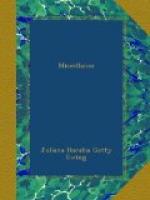In Scotland the beech-chips and branches are burned to smoke herrings, and pyroligneous acid (a form of which is probably known to any of our young readers who suffer from toothache as creosote!) is distilled from them. Mr. Loudon tells us that the word “book” comes from the German word buch, which, in the first instance, means a beech, and was applied to books because the old German bookbinders used beech-wood instead of paste-board for the sides of thick volumes. Beech-wood is especially good for fuel. Only the sycamore, the Scotch pine, and the ash give out more heat and light when they burn. Beech-nuts—or beech-mast, as it is called—are eaten by many animals. Pigs, deer, poultry, &c., are turned into beech-woods to fatten on the mast. Squirrels and dormice delight in it. In France it is used to make beech-oil. This oil is used both for cooking and burning, and for the latter purpose has the valuable property of having no nasty smell.
Of the beauty of the beech as a forest-tree—let artists rave! Its smooth and shapely bole does not tempt the sketcher’s eye alone. To the lover and the school-boy (and, alas! to that inartistic animal the British holiday-maker) it offers an irresistible surface for cutting names and dates. Upon its branches and beneath its shadow grow many fungi, several of which are eatable. Truffles are found there; those underground dainties which dogs (and sometimes pigs!) are trained to grub up for our benefit. They discover the whereabouts of the truffle by scent, for there is no sign of it above ground. Nothing else will grow under beech-trees, except holly.
Scarcely less charming than the beech-forests are beech-hedges. They cut and thrive with cutting like yew-hedges.
“Little woods” of beech are common in Buckinghamshire. They are chiefly grown for the charcoal, which is valuable for gunpowder.
“Copper-Beeches”—red-leaved beech-trees, very beautiful for ornamental purposes—all come from one red-leaved beech, a sort of freak of nature, which was found about a century ago in a wood in Germany.
The Birch (Betula alba, &c.) is also a tree of very distinctive appearance. The silver-white bark, which peels so delightfully under childish fingers, is not less charming to the sketcher’s eye, whether as a near study or as gleaming points of high light against the grey greens and misty purples of a Highland hillside. It is emphatically the tree of the Highlands of the North. It bends and breaks not under the wildest winds, it thrives on poor soil, and defies mist and cold. So varied are its uses that it has been said that the Scotch Highlander makes everything of birch, from houses to candles, and beds to ropes! The North American Indians and the Laplanders apply it almost as universally as the Chinese use paper. The wigwams or huts of the North American Indians are made of birch-bark laid over a framework of birch-poles or trunks, and their canoes or boats are cased in it. The Laplander makes his great-coat of it,—a circular poncho with a hole for his head,—as well as his houses and his boots and shoes. It will be easily believed that birch-bark was used in ancient times for writing on before the invention of paper.




